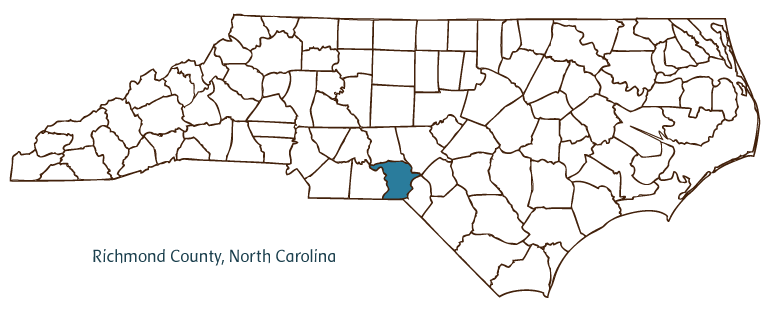RICHMOND COUNTY GOVERNMENT:
www.richmondnc.com
COUNTY SEAT: Rockingham
FORMED: 1779
FORMED FROM: Anson
LAND AREA: 473.82 square miles
2020 POPULATION ESTIMATE: 42,946
White: 61.3%
Black/African American: 31.9%
American Indian: 3.3%
Asian: 1.0%
Pacific Islander: 0.2%
Two or more races: 2.3%
Hispanic/Latino: 6.8% (of any race)
From State & County QuickFacts, US Census Bureau, 2020.
CONGRESSIONAL DISTRICT: 9TH
BIOGRAPHIES FOR![]()
Richmond County
 WILDLIFE PROFILES FOR
WILDLIFE PROFILES FOR
Piedmont region
GEOGRAPHIC INFORMATION
REGION: Piedmont
RIVER BASIN: Lumber, Yadkin-Pee Dee, Map
NEIGHBORING COUNTIES: Anson, Montgomery, Moore, Scotland

Richmond County, located in the Piedmont region in southern North Carolina, was formed in 1779 from Anson County and was named after Charles Lennox, the third duke of Richmond. Early inhabitants of the area included the Saura (Cheraw) Indians, followed by Highland Scot, German, Scotch-Irish, and English settlers. Rockingham, the county seat, was established in 1779 as Richmond Court House; the name was changed in 1785 to honor Charles Watson Wentworth, the Marquess of Rockingham, who maintained friendly relations with the American colonies during the Revolution. Other communities in the county include Hamlet, Ellerbe, Ghio, Cordova, and Hoffman. Notable physical features of the county include several lakes, as well as the Pee Dee River, Seaburn Spring, and Naked, Hamer, and Buffalo Creeks.
The North Carolina Motor Speedway in Rockingham, known locally as "the Rock," was an important center for auto racing for decades, hosting NASCAR's AC Delco 200 Busch Grand National Race and the AC Delco 400 Winston Cup Race and bringing thousands of visitors annually to the county. The track held its last race in February 2004*. County cultural institutions include the National Railroad Museum and Hall of Fame, the Rankin Museum of American and Natural History, the Richmond County Community Theatre, and Richmond County Community Concert. Hamlet and Ellerbe have historic districts with many historic houses. The county also hosts a number of annual events, such as Seaboard Festival Day and the Rankin Museum Festival.
Richmond County produces agricultural goods such as cotton, peaches and other fruits, corn, tobacco, vegetables, and soybeans. Manufactured products include textiles and apparel, wood moldings, furniture, plastic closures, poultry processing, and steel fabricators. In 2004 Richmond County's population was estimated to be 46,400.
Annotated history of Richmond ;County's formation:
For an annotated history of the county's formation, with the laws affecting the county, boundary lines and changes, and other origin information, visit these references in The Formation of the North Carolina Counties (Corbitt, 2000), available online at North Carolina Digital Collections (note, there may be additional items of interest for the county not listed here):
County formation history: https://digital.ncdcr.gov/Documents/Detail/the-formation-of-the-north-ca...
Index entry for the county: https://digital.ncdcr.gov/Documents/Detail/the-formation-of-the-north-ca...
References:
John Hutchinson, No Ordinary Lives: A History of Richmond County, North Carolina, 1750-1900 (1998).
Additional resources:
Corbitt, David Leroy. 2000. The formation of the North Carolina counties, 1663-1943. https://digital.ncdcr.gov/Documents/Detail/the-formation-of-the-north-carolina-counties-1663-1943/3692099?item=4553233 (accessed June 20, 2017).
Richmond County Government: http://www.richmondnc.com/
Richmond County Chamber of Commerce: https://richmondcountychamber.com/
DigitalNC, Richmond County: https://www.digitalnc.org/counties/richmond-county/
North Carolina Digital Collections (explore by place, time period, format): https://digital.ncdcr.gov
Image credits:
Rudersdorf, Amy. 2010. "NC County Maps." Government & Heritage Library, State Library of North Carolina.
1 January 2006 | Mazzocchi, Jay
